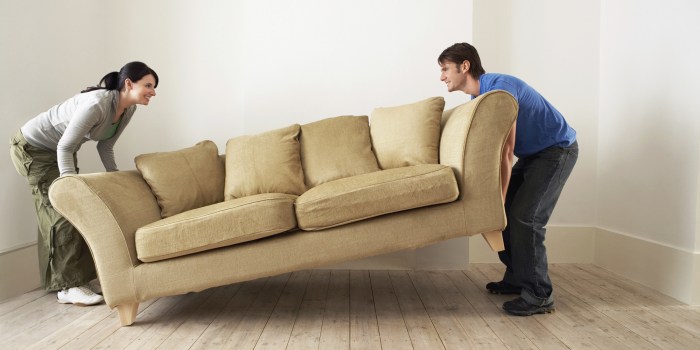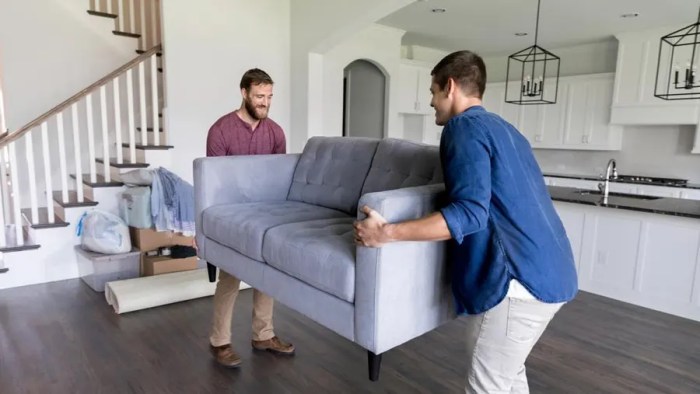Move furniture – Moving furniture is an inevitable part of life, whether you’re relocating to a new home, redecorating your current space, or simply rearranging your belongings. While it may seem like a straightforward task, there are many factors to consider to ensure a safe and successful move.
This comprehensive guide will provide you with everything you need to know about move furniture, from planning and preparation to execution and safety precautions. We’ll cover different moving techniques, equipment options, space optimization strategies, and more. Whether you’re a seasoned pro or a first-time mover, this guide has something for you.
Moving Furniture Basics
Moving furniture can be a daunting task, but with the right equipment and preparation, it can be done safely and efficiently. Here’s a comprehensive guide to help you navigate the process.
Types of Furniture Moving Equipment
There are various types of furniture moving equipment available, each designed for specific purposes.
- Furniture Dolly:A flat, wheeled platform that allows you to move heavy furniture easily.
- Moving Straps:Strong, adjustable straps that help secure and lift furniture.
- Furniture Sliders:Slick pads that reduce friction and make furniture easier to slide across surfaces.
- Furniture Lifter:A tool that helps lift and stabilize heavy furniture.
Preparing Furniture for Moving
Before moving furniture, it’s essential to prepare it properly.
- Empty drawers and shelves:Remove all contents to reduce weight and prevent damage.
- Disassemble furniture:If possible, disassemble furniture into smaller, manageable pieces.
- Wrap fragile items:Protect delicate items by wrapping them in bubble wrap or packing paper.
- Secure loose parts:Tape or tie down any loose parts, such as knobs or handles.
Safety Precautions
Moving furniture can be physically demanding, so it’s crucial to prioritize safety.
- Lift with your legs, not your back:Bend your knees and lift using your leg muscles.
- Wear gloves:Protect your hands from splinters or sharp edges.
- Use proper lifting techniques:Keep your back straight and avoid twisting or jerking movements.
- Clear the path:Remove any obstacles or clutter from the moving path.
Furniture Moving Methods
Furniture moving involves a variety of techniques to safely and efficiently relocate furniture items. These methods can be categorized into three main types: lifting, carrying, and sliding.
Lifting
Lifting is the most straightforward method and involves raising the furniture item off the ground and carrying it to its new location. This method is suitable for smaller and lighter items that can be easily handled by one person.
- Advantages:Simple and efficient for small items.
- Disadvantages:Can be strenuous and risky for heavier items.
Carrying
Carrying involves holding the furniture item at waist height and transporting it to its new location. This method is suitable for medium-sized items that can be comfortably carried by two people.
Moving furniture can be a daunting task, especially when you’re relocating across the country. Instead of handling the logistics yourself, consider exploring shipping furniture across country services. These professionals will ensure your belongings arrive safely and efficiently, giving you peace of mind as you settle into your new home.
Don’t let furniture relocation add stress to your move; entrust it to experts and focus on the exciting journey ahead.
- Advantages:Less strenuous than lifting, provides better control.
- Disadvantages:Requires two people, can be awkward for large items.
Sliding
Sliding involves moving the furniture item across the floor without lifting it. This method is suitable for heavy or bulky items that are difficult to lift or carry. It requires the use of sliders or furniture pads to protect the floor.
- Advantages:Less strenuous, can be used for heavy items.
- Disadvantages:Can damage floors, requires additional equipment.
The choice of furniture moving method depends on the size, weight, and shape of the item, as well as the available space and the presence of obstacles. It is important to choose the most appropriate method to ensure safety and prevent damage to both the furniture and the floor.
Furniture Moving Equipment
Furniture moving can be a daunting task, but with the right equipment, it can be made much easier. There are a variety of furniture moving equipment available, each with its own features, benefits, and limitations. It is important to choose the right equipment for the job to ensure that the furniture is moved safely and efficiently.
The following table compares the different types of furniture moving equipment:
| Equipment | Features | Benefits | Limitations |
|---|---|---|---|
| Dollies | – Flat platform with wheels
|
– Can handle heavy loads
|
– Can be difficult to maneuver in tight spaces
|
| Hand trucks | – U-shaped frame with wheels
|
– Can handle heavy loads
|
– Not suitable for moving delicate items
|
| Furniture sliders | – Small, slippery pads that are placed under furniture
|
– Easy to use
|
– Not suitable for moving heavy objects
Moving furniture can be a daunting task, but it can be made easier with the right tools and equipment. One great option is to purchase national furniture , which is specifically designed to be easy to move and assemble. This type of furniture is often made from lightweight materials, such as aluminum or plastic, and it can be easily disassembled for transport. If you are looking for a way to make moving furniture easier, national furniture is a great option.
|
When choosing furniture moving equipment, it is important to consider the following factors:
- The weight of the furniture
- The size of the furniture
- The distance the furniture needs to be moved
- The type of flooring the furniture will be moved on
By considering these factors, you can choose the right furniture moving equipment for the job and ensure that the furniture is moved safely and efficiently.
Furniture Moving Safety

Moving furniture can be a physically demanding task, posing potential hazards that could lead to accidents and injuries. It’s crucial to approach this task with caution and implement proper safety measures to prevent any harm.
To ensure a safe moving experience, consider the following safety tips:
Lifting Techniques
-
-*Assess the weight and size of the furniture
Before attempting to lift, estimate the weight and dimensions of the piece to determine if assistance is needed.
-*Use proper body mechanics
Lift with your legs, keeping your back straight and core engaged. Avoid twisting or bending your spine.
-*Team up if necessary
If the furniture is too heavy or bulky for one person, ask for assistance from others to prevent straining or injury.
Protective Gear
-
-*Wear appropriate clothing
Moving furniture can be a daunting task, but it doesn’t have to be. With the help of a reputable furniture movers company , you can rest assured that your furniture will be handled with care and transported safely to your new home.
These companies have the experience and expertise to move furniture of all shapes and sizes, so you can relax knowing that your belongings are in good hands. So, if you’re planning to move furniture, be sure to contact a professional furniture movers company for a hassle-free experience.
Choose comfortable, non-restrictive clothing that allows for ease of movement. Avoid loose clothing or dangling jewelry that could get caught.
-*Use gloves
Gloves provide a secure grip and protect your hands from splinters, sharp edges, or heavy lifting.
-*Wear safety glasses
Safety glasses shield your eyes from dust, debris, or flying objects that may arise during the moving process.
Other Safety Precautions
-
-*Clear the path
Remove any obstacles or tripping hazards from the moving route, such as cords, rugs, or clutter.
-*Secure loose parts
Disassemble any detachable components, such as drawers or shelves, to reduce the weight and prevent them from falling off during transport.
-*Use moving equipment wisely
Employ dollies, furniture sliders, or lifting straps to assist with heavy lifting and reduce strain on your body.
-*Take breaks
Regular breaks allow your body to rest and prevent fatigue, which can lead to accidents.
-*Seek professional help if needed
If you encounter any furniture that is excessively heavy or awkward to move, don’t hesitate to contact professional movers for assistance.
Furniture Moving Planning
Planning a furniture move in advance is crucial for a successful relocation. It helps you organize the process, reduce stress, and avoid costly mistakes.
Here’s a step-by-step guide to creating a moving plan:
Step 1: Assess Your Needs
- Determine the volume of furniture and belongings you’re moving.
- Identify any oversized or fragile items that require special handling.
- Decide if you’ll hire professional movers or do it yourself.
Step 2: Set a Budget
- Research the average cost of moving in your area.
- Get quotes from multiple moving companies if hiring professionals.
- Factor in additional expenses like packing materials, insurance, and tips.
Step 3: Choose a Moving Date
- Select a date that allows ample time for preparation and unpacking.
- Consider weekends or off-season periods for lower moving rates.
- Book your movers or reserve a moving truck in advance.
Step 4: Declutter and Pack
- Sort through your belongings and discard or donate anything you don’t need.
- Pack non-essential items first and label boxes clearly.
- Leave essential items like toiletries and medications unpacked for easy access.
Step 5: Prepare Your Furniture
- Disassemble furniture that can be taken apart.
- Wrap fragile items in protective materials like bubble wrap or packing paper.
- Secure loose parts and hardware in labeled bags.
Step 6: Arrange Transportation
- If hiring movers, confirm the moving arrangements and arrival time.
- If renting a moving truck, reserve it in advance and ensure you have the necessary driving license.
- Plan the loading and unloading process to minimize damage.
Step 7: Prepare Your New Home
- Clean the new home and make any necessary repairs.
- Measure the rooms to determine the furniture layout.
- Plan the placement of utilities and appliances.
Step 8: Move Day Coordination
- Supervise the movers or load the moving truck yourself.
- Check the furniture for any damage during transit.
- Unload and place the furniture in the designated areas.
Furniture Moving and Space Optimization
Moving furniture can be a daunting task, especially if you’re trying to optimize space in your new home. But with a little planning and creativity, you can make the most of your space and create a functional and stylish living environment.
Maximize Storage, Move furniture
One of the best ways to optimize space when moving furniture is to maximize storage. This can be done by using furniture with built-in storage, such as ottomans with storage compartments or beds with drawers. You can also use shelves, baskets, and bins to store items that you don’t use on a regular basis.
Minimize Clutter
Another important way to optimize space is to minimize clutter. This means getting rid of anything you don’t need or use anymore. You can donate unwanted items to charity, sell them online, or simply throw them away. Once you’ve decluttered, you’ll be surprised at how much more space you have.
Arrange Furniture for Functionality and Aesthetics
The way you arrange your furniture can also have a big impact on how much space you have. When arranging furniture, keep the following tips in mind:* Place furniture against walls to free up floor space.
- Use smaller pieces of furniture to make a room feel larger.
- Choose furniture that is proportionate to the size of the room.
- Avoid blocking windows and doorways.
- Create focal points in the room with statement pieces of furniture.
Furniture Moving and Home Decor
Moving furniture can significantly impact the overall decor of a home. By carefully selecting pieces that complement the existing style and color scheme, you can create a cohesive and visually appealing living space.
Choosing Furniture
When choosing furniture for a new space, consider the following tips:
- Color Scheme:Consider the existing color scheme of the room and choose furniture in complementary or contrasting hues.
- Textures:Incorporate different textures into your furniture choices to add visual interest and depth.
- Styles:Choose furniture pieces that blend seamlessly with the overall style of the room, whether it be modern, traditional, or eclectic.
Importance of Planning
Proper planning is crucial for successful furniture moving and home decor. Consider the following steps:
- Measure the Space:Determine the dimensions of the room and the furniture pieces to ensure they fit comfortably.
- Plan the Layout:Sketch out different furniture arrangements to visualize the best possible layout.
- Consider Lighting:Pay attention to the natural and artificial lighting in the room and arrange furniture accordingly.
Optimizing Space
Furniture moving also presents an opportunity to optimize space and improve functionality:
- Multipurpose Furniture:Choose furniture pieces that serve multiple purposes, such as ottomans with storage or beds with built-in drawers.
- Vertical Storage:Utilize vertical space by incorporating shelves, bookcases, and tall cabinets.
- Declutter:Remove unnecessary items and declutter the space to create a sense of openness.
Furniture Moving and Sustainability

Furniture moving can have a significant environmental impact, from the production and disposal of moving materials to the transportation of furniture itself. However, there are several ways to reduce waste and promote sustainability during a move.
Recycling and Disposal
- Donate unwanted furniture:Donating gently used furniture to charities or community organizations is an excellent way to keep it out of landfills and help those in need.
- Repurpose furniture:Before discarding old furniture, consider whether it can be repurposed for a different use. For example, an old dresser could be converted into a bookshelf or a headboard.
- Recycle moving materials:Cardboard boxes, packing paper, and other moving materials can be recycled at most recycling centers. Check with your local recycling program for specific guidelines.
Transportation
- Choose a moving company with sustainability practices:Some moving companies offer eco-friendly services, such as using hybrid or electric vehicles and recycling moving materials.
- Consolidate shipments:If possible, consolidate multiple shipments into one to reduce the number of transportation trips.
- Plan the move efficiently:By carefully planning the move and optimizing the use of space, you can minimize the amount of transportation required.
Closing Notes: Move Furniture

Moving furniture can be a challenging but rewarding task. By following the tips and advice Artikeld in this guide, you can ensure a safe and successful move. Remember to plan ahead, choose the right equipment, and take all necessary safety precautions.
With a little preparation and effort, you can move your furniture with ease and create a space that you love.
FAQ Insights
What is the best way to lift heavy furniture?
Use proper lifting techniques, such as bending your knees and keeping your back straight. If possible, get help from another person to lift the furniture safely.
What is the best way to protect furniture during a move?
Use furniture pads or blankets to wrap and protect your furniture from scratches and dents. You can also use plastic wrap to cover upholstered furniture.
How can I optimize space when moving furniture?
Use vertical space by stacking items and using shelves. Consider multi-purpose furniture that can serve multiple functions.